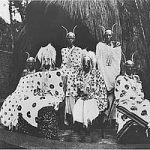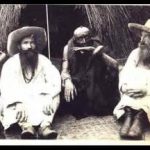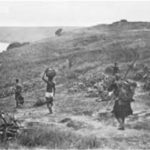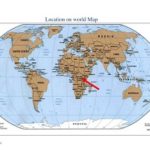The Ibaba Revolt
Under German rule, Kinyagan notables such as Seekabaraga and Nyankiiko had gained power and wealth. Although nominally the local representatives of Rwidegembya, Rwagataraka’s father, they were not closely supervised. Rwidegembya, who had other regions to command as well, spent much of his time at court and did not pay much attention to local matters in Kinyaga. Both Seekabaraga and Nyankiiko, his nominal subordinates, also had clientship ties to the royal court, and they aspired to become direct representatives of the central government without the intermediary of a chief like Rwidegembya. But from around 1914, and particularly after the Belgian victory in 1916, Rwagataraka began taking affairs into his own hands. These efforts threatened the local position of the Kinyagan chiefs.
During the first year of Belgian rule, the military administration regarded the Rwandan king, Yuhi Musinga, with strong suspicion. Prominent regional chiefs saw their chance and, defying royal authority, took it upon themselves to deal direcdy with the Belgians. Musinga was unable either to discipline those chiefs who dealt directly with the Belgians or to protect those whom the Belgians sought to punish. As the king’s prestige and control over the chiefs declined, his political power was undermined. Furthermore, initially Belgian policy favored the Hutu, particularly in the northwest (a region recently and only imperfectly incorporated into the Rwandan polity).
These alterations in the power equation, along with the hardship caused by a severe famine (referred to as “Rumanura”) in the northwest, stimulated discontent and hostility against the Belgians. Frightened by rumors of imminent revolt, the occupying force reacted with severe and arbitrary action. Rwidegembya was imprisoned in December 1916, apparently to instill respect, and hopefully order, through the simple demonstration of Belgian power directed against one of the greatest of the land. It was reasoned that such a show of force would dampen rumors and the will to revolt.
Two months later, Musinga himself was jailed briefly because of allegations (said by some to have been promulgated by Rwagataraka) that the king had been in contact with Germans. The accusations were subsequently judged false and Musinga was released. Not long alter, the Belgians planned to bring Musinga to trial (and were even prepared to execute him) following an accusation that the king and some of his chiefs had poisoned the milk and butter of Belgian officers. But this too remained unsubstantiated, and the trial never took place. Nonetheless the accusations were known, rumors flew, and Musinga’s standing was severely tarnished. Preeminent among those who stepped in to take advantage of the king’s weakened position were Rwidegembya, Kayondo, and Rwubusisi-all three members of the queen mother’s lineage (Abakagara), which since Rucunshu had been consolidating its control over hills and cattle throughout Rwanda.
When Major Declerck was installed as the first Belgian Resident of Rwanda (in May 1917) he reversed previous policy as part of an effort to gain Musinga’s support, and permitted the king to arrest the Abakagara chiefs who had flouted royal authority. On Musinga’s orders the three chiefs were imprisoned in Kigali and released only alter they had formally requested the king’s pardon. It was in this atmosphere of intrigue and treason that Kinyagan chiefs made their move. Led by Seekabaraga and Nyankiiko, members of the Abadegede, Abeerekande, and several other lineages in Kinyaga sought to free themselves of Rwagataraka’s authority. Rwagataraka hastily took to his canoe and fled out on the lake to escape attack.
In planning their revolt, the Kinyagans probably took into account Rwagataraka’s former support of the Germans, Rwidegembya’s apparently weakened position, and Musinga’s declining power in the face of recent Belgian administrative actions. The Kinyagan chiefs might have hoped for Belgian support of their bid for local autonorny (implicitly against central court power); they may at the same time have sought support from the king by pledging direct dependence on the court, without the intermediary of a discredited Rwidegembya and his son. Such a strategy would have been no more than the continuation of earlier policies of Kinyagan chiefs relative to central court politics: to seek protection and in effect local autonomy through direct clientship to the king.
But the Kinyagan revolt, known as lbaba, met with only temporary success. Rwagataraka appealed to his father (recently released from prison and reinstated at the court) and Musinga. Rwidegernbya held several important posts in central politics and had clients throughout the country. And Rwagataraka’s great-aunt, Kanjogera, had used her position as queen mother to acquire a key role in decision-making at the center. The Kinyagans who led Ibaba could hardly claim such powerful contacts. Not surprisingly, the king upheld Rwagataraka’s suzerainty, and the chief resumed his stewardship of Impara. In the face of superior Abakagara influence at the court the attempt by local Tuutsi to assert their autonomy had failed. Seekabaraga and Nyankiiko had gained power within the Kinyagan context by accepting and manipulating central institutions of clientship. Yet their very acceptance of central Rwandan customs and support made them vulnerable. Once they were incorporated into the central political arena, the institutions they had accepted and used to their advantage could be turned against them.
In the aftermath of Ibaba, Rwagataraka purged many Kinyagans, notably members of the Abadegede and Abeerekande lineages. He strove to centralize power, eliminating potential rivals and appointing chiefs loyal to him to fill the vacated positions. Those deposed had little recourse; to regain status and wealth, they needed a patron, and often that patron would be Rwagataraka himself. The turnover in personnel reflected a tightening of control from above, a pattern which continued in the years following Ibaba.
The Increasing Powers of Patron-Chiefs
Thepolicies and use of clientship practiced by Rwagataraka were replicated at lower levels of administrative structures in Kinyaga, as hill chiefs, sharing in the power of the chief, their “patron,” used clientship to reinforce their control. During the period after 1917, as the Belgian rulers began to organize colonial administration in the kingdom, a number of new demands were made on rural people. For must of the new demands, the administration relied on the chiefs, particularly the hill chiefs, as intermediaries to the population. Political authorities thus gained additional power; as the demands of the administration increased, so too did the chiefs’coercive capacity; what were intended as administrative tools by the Belgians were all too easily and frequently turned into political weapons in the hands of the Tuutsi chiefs.
Kinyagans were called upon tu supply food and cattle for European needs, serve as porters, and build roads. Token salaries were paid to workers on principal roads, but “paths and secondary roads” were to be maintained by the residents of each hill, as a form of corvée (akazi)
The head tax, introduced in 1917, increased regularly from 1926. Meanwhile, during the 1920s expansion of European settler enterprises in Kinyaga and in Kivu to the west created growing demands for workers.
It was common practice for a chief who collected goods or cattle or who recruited porters and road workers during this periocl to keep for himself any remuneration paid; the individuals who actually provided the food or did the work often received nothing. The chiefs used these resources for accumulation (building up their herds) or consumption (buying cloth, for example). They also diverted people into working in the chiefs’own fields. A 1926 administrative directive instructing Territorial Administrators to put an end to such practices singled out numerous abuses:
In the territories where food supplies are requested from the chiefdoms, the notables sometimes proceed in the following manner: In the case of beef, cattle are requisitioned from various hills or from a variety of abagaragu. The notable who requisitions these animals delivers one to the [administrative] post where he collects the payment, and places the others in his herds or else sells them to the traders. A similar method is used in the case of food supples. With the profits obtained the persons concerned buy cloth.
When porters are requested from the chief doms, it happens that a certain number of these are not used. These are sometimes used by the notables for cultivating the latter’s fields.
Since refusal to comply with any of the demands the hill chief made would expose a person to the possibility of losing his land, cultivators experienced a significant decline in security of tenure. As we have seen, it was often in the interests of a chief to expel a local landholder and install others who then became directly dependent on the chief for land; the previous tenant had to move, hoping to obtain land from another chief elsewhere. Should such incidents be brought to the attention of the authorities, the chief could plead that the victim had refused to comply with some order winch the chief was “entitled” to give according to colonial regulations (to pay taxes, to work for Europeans), or “traditional” practice (ubuhake service, land prestations, ubureetwa). A Territorial Administrator with several years of experience in Rwanda openly acknowledged the difficulty of judging in such cases-but he was willing to give the benefit of the doubt to the chiefs for the sake of administrative expedience.
Many Kinyagans remarked upon the tyrannicaI practices of the politico-administrative authorities during this period; their comments are exemplified in the following accounts.
That man [hilI chief at Nyamavugo] commanded like the others; when someone didn’t have beans to give as prestations, he expelled him from his land, and likewise for someone who didn’t have mats to give.
In fact there was no recourse to the courts; a chief could take someone’s goods and could chase him away or have him “killed” by another chief.
They would come to take your cow on the pretext that you were a rebel, and you couldn’t say anything. . You would let your cow go, for at the least resistance you would be put in chains or sometimes killed. And in such a case you could not introduce a court case to claim your rights on the cow.
After the cows of Gisazi (Chief of the Bugarama region) had perished in the Iragara epidemic (1920-1921) he went around seizing cattle from people, both those who were clients and those who were not. The informant’s lineage lost a cow in this manner.
Another source of power for chiefs was the abolition of igikingi domains begun in 1926. We have noted that an igikingi consisted of land held by carde owners, in which the proprietor controlled the use of pasturage and the distribution of agricultural land. But ibikingi, regarded as “anomalies” by the Belgian administration, were eliminated as part of the European policy of regroupment; abolition of ibikingi was also viewed by the administration as a means of providing plots to cultivators who had insufficient land.
In one sense, Belgian policy merely extended a practice that had begun well before 1926, when hill chiefs appointed from outside attempted to gain control over land within their administrative domain. But through standardization efforts under colonial rule, subchiefs now obtained a “legal” right to take over igikingi land. The major victims, cattle-owners who did not themselves hold any political office, found their pastures being turned into agricultural plots, distributed by the subchiefs.
Presumably the former land clients of igikingi-holders would have found it necessary to seek some form of linkage with the subchief (the new “land patron”), often through ubuhake clientship. Ubuhake cattle clientship also became important for those who had or acquired cattle
and lived in regions of high population density. With the reduction in amount of pasturage, and the control by subchiefs over that land, persons without an ubuhake patron oftencloud flot find pasturage for their cattle. This was particularly true on the Nyamirundi peninsula, where cattle density in relation to population was the highest of any area of Kinyaga.
https://uk.amateka.net/the-ibaba-revolt/https://uk.amateka.net/wp-content/uploads/2020/08/image.pnghttps://uk.amateka.net/wp-content/uploads/2020/08/image-150x150.pngModel CitizenshipUnder German rule, Kinyagan notables such as Seekabaraga and Nyankiiko had gained power and wealth. Although nominally the local representatives of Rwidegembya, Rwagataraka's father, they were not closely supervised. Rwidegembya, who had other regions to command as well, spent much of his time at court and did not pay...BarataBarata rpierre@ikaze.netAdministratorAMATEKA | HISTORY OF RWANDA




